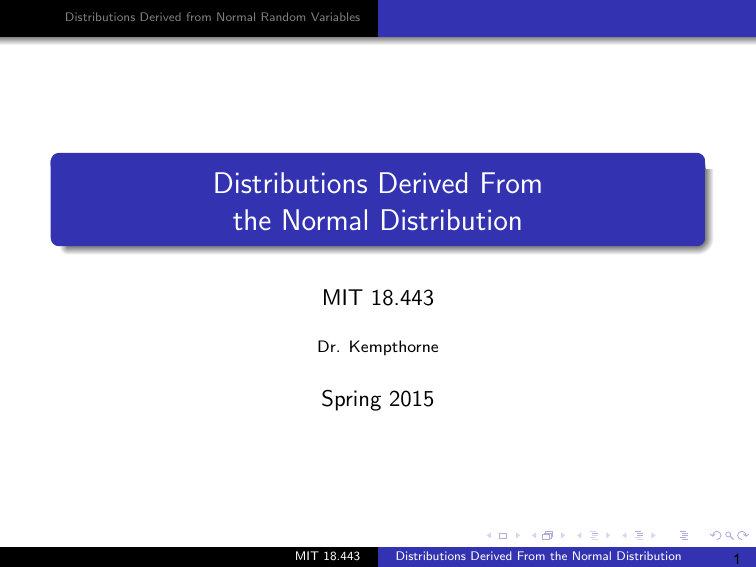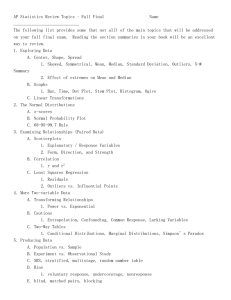Document 13434520
advertisement

Distributions Derived from Normal Random Variables Distributions Derived From the Normal Distribution MIT 18.443 Dr. Kempthorne Spring 2015 MIT 18.443 Distributions Derived From the Normal Distribution 1 Distributions Derived from Normal Random Variables χ2 , t, and F Distributions Statistics from Normal Samples Outline 1 Distributions Derived from Normal Random Variables χ2 , t, and F Distributions Statistics from Normal Samples MIT 18.443 Distributions Derived From the Normal Distribution 2 Distributions Derived from Normal Random Variables χ2 , t, and F Distributions Statistics from Normal Samples Normal Distribution Definition. A Normal / Gaussian random variable X ∼ N(µ, σ 2 ) has density function: 1 2 2 f (x) = √ e −(x−µ) /2σ , −∞ < x < +∞. σ 2π with mean and variance parameters: J +∞ µ = E [X ] = −∞ xf (x)dx J +∞ σ 2 = E [(X − µ)2 ] = −∞ (x − µ)2 f (x)dx Note: −∞ < µ < +∞, and σ 2 > 0. Properties: Density function is symmetric about x = µ. f (µ + x ∗ ) = f (µ − x ∗ ). f (x) is a maximum at x = µ. f "" (x) = 0 at x = µ + σ and x = µ − σ (inflection points of bell curve) Moment generating function: 2 2 MX (t) = E [e tX ] = e µt+σ t /2 MIT 18.443 Distributions Derived From the Normal Distribution 3 Distributions Derived from Normal Random Variables χ2 , t, and F Distributions Statistics from Normal Samples Chi-Square Distributions Definition. If Z ∼ N(0, 1) (Standard Normal r.v.) then U = Z 2 ∼ χ21 , has a Chi-Squared distribution with 1 degree of freedom. Properties: The density function of U is: −1/2 fU (u) = u√2π e −u/2 , 0 < u < ∞ Recall the density of a Gamma(α, λ) distribution: λα α−1 −λx g (x) = Γ(α) x e , x > 0, So U is Gamma(α, λ) with α = 1/2 and λ = 1/2. Moment generating function MU (t) = E [e tU ] = [1 − t/λ]−α = (1 − 2t)−1/2 MIT 18.443 Distributions Derived From the Normal Distribution 4 Distributions Derived from Normal Random Variables χ2 , t, and F Distributions Statistics from Normal Samples Chi-Square Distributions Definition. If Z1 , Z2 , . . . , Zn are i.i.d. N(0, 1) random variables V = Z12 + Z22 + . . . Zn2 has a Chi-Squared distribution with n degrees of freedom. Properties (continued) The Chi-Square r.v. V can be expressed as: V = U1 + U2 + · · · + Un where U1 , . . . , Un are i.i.d χ21 r.v. Moment generating function MV (t) = E [e tV ] = E [e t(U1 +U2 +···+Un ) ] = E [e tU1 ] · · · E [e tUn ] = (1 − 2t)−n/2 Because Ui are i.i.d. Gamma(α = 1/2, λ = 1/2) r.v.,s V ∼ Gamma(α = n/2, λ = 1/2). 1 Density function: f (v ) = n/2 v (n/2)−1 e −v /2 , v > 0. 2 Γ(n/2) (α is the shape parameter and λ is the scale parameter) MIT 18.443 Distributions Derived From the Normal Distribution 5 Distributions Derived from Normal Random Variables χ2 , t, and F Distributions Statistics from Normal Samples Student’s t Distribution Definition. For independent r.v.’s Z and U where Z ∼ N(0, 1) U ∼ χ2r the distribution of T = Z / U/r is the t distribution with r degrees of freedom. Properties The density function of T is −(r +1)/2 Γ[(r + 1)/2] t2 f (t) = √ 1+ , −∞ < t < +∞ r r πΓ(r /2) For what powers k does E [T k ] converge/diverge? Does the moment generating function for T exist? MIT 18.443 Distributions Derived From the Normal Distribution 6 Distributions Derived from Normal Random Variables χ2 , t, and F Distributions Statistics from Normal Samples F Distribution Definition. For independent r.v.’s U and V where U ∼ χ2m V ∼ χ2n U/m is the V /n F distribution with m and n degrees of freedom. (notation F ∼ Fm,n ) Properties the distribution of F = The density function of F is m Γ[(m + n)/2] m n/2 m/2−1 f (w ) = w 1+ w Γ(m/2)Γ(n/2) n n with domain w > 0. E [F ] = E [U/m] × E [n/V ] = 1 × n × 1 n−2 = n n−2 −(m+n)/2 , (for n > 2). If T ∼ tr , then T 2 ∼ F1,r . MIT 18.443 Distributions Derived From the Normal Distribution 7 Distributions Derived from Normal Random Variables χ2 , t, and F Distributions Statistics from Normal Samples Outline 1 Distributions Derived from Normal Random Variables χ2 , t, and F Distributions Statistics from Normal Samples MIT 18.443 Distributions Derived From the Normal Distribution 8 Distributions Derived from Normal Random Variables χ2 , t, and F Distributions Statistics from Normal Samples Statistics from Normal Samples Sample of size n from a Normal Distribution X1 , . . . , Xn iid N(µ, σ 2 ). n 1n Sample Mean: X = Xi n i=1 n Sample Variance: S 2 = 1 n (Xi − X )2 n−1 i=1 Properties of X The moment generating function of X is n t MX (t) = E [e tX ] = E [e n 1 Xi ] = = e i.e., X ∼ n 1 MXi (t/n) σ 2 /n µt+ 2 t 2 = 2 n µ(t/n)+ σ2 (t/n)2 ] i=1 [e N(µ, σ 2 /n). MIT 18.443 Distributions Derived From the Normal Distribution 9 Distributions Derived from Normal Random Variables χ2 , t, and F Distributions Statistics from Normal Samples Independence of X and S 2 . Theorem 6.3.A The random variable X and the vector of random variables (X1 − X , X2 − X , . . . , Xn − X ) are independent. Proof: Note that X and each of Xi − X are linear combinations of X1 , . . . , Xn , i.e., Ln X = ai Xi = aT X = U and L1n (k) (k) T Xk − X = 1 bi Xi = (b ) X = Vk where X = (X1 , . . . , Xn ) a = (a1 , . . . , an ) = (1/n, . . . , 1/n) (k) (k) (k) b = (b1 , . . . , bn ) . 1 − n1 , for i = k (k) with bi = − n1 , for i = k U and V1 , . . . , Vn are jointly normal r.v.s U is uncorrelated (independent) of each Vk MIT 18.443 Distributions Derived From the Normal Distribution 10 Distributions Derived from Normal Random Variables χ2 , t, and F Distributions Statistics from Normal Samples Independence of U = aT X and V = bT X where X = (X1 , . . . , Xn ) a = (a1 , . . . , an ) = (1/n, . . . , 1/n) b = (b1 , . . . , bn ) . 1 − n1 , for i = k (k) with bi = bi = (so V = Vk ) 6 k − n1 , for i = Proof: Joint MGF of (U, V ) factors into MU (s) × MV (t) T T MU,V (s, t) = E [e sU+tV [e sa X+tb X ] P P ] = EP i ai Xi ]+t[ i bi Xi ] ] = E [e i [(sai +tbi )Xi ] ] = E [e s[ P ∗ [t X ] ∗ = E [e i i i ] with ti = (sai + tbi ) n n Qn [ti∗Xi ] = E [e ] = MXi (ti∗ ) i=1 i=1 P 2 2 Pn ∗ 2 ti∗ µ+ σ2 (ti∗ )2 µ( ni=1 ti∗ )+ σ2 i=1 [(ti ) ] e = e i=1 P n 2 2 2 2 2 +2sta b ] i i e µ(s×1+t×0)+σ /2[ i=1 [s ai +t bi P n 2 /n)s 2 /2 2 σ 2 /2 2 sµ+(σ t×0+t b i =1 i ] [e ] × [e Qn = = = L = [mgf of N(µ, σ 2 /n)] × [mgf of N(0, σ 2 · ni=1 bi2 ] MIT 18.443 Distributions Derived From the Normal Distribution 11 Distributions Derived from Normal Random Variables χ2 , t, and F Distributions Statistics from Normal Samples Independence of X and S 2 Proof (continued): Independence of U = L X and each Vk = Xk − X gives X and S 2 = n1 Vi2 are independent. Random variables/vectors are independent if their joint moment generating function is the product of their individual moment generating functions: MU,V1 ,...,Vn (s, t1 , . . . , tn ) = E [e sU+t1 V1 +···tn Vn ] = MU (s) × M(t1 , . . . , tn ). Theorem 6.3.B The distribution of (n − 1)S 2 /σ 2 is the Chi-Square distribution with (n − 1) degrees of freedom. Proof: Ln Xi −µ 2 Ln 1 Ln 2 = (X − µ) = i=1 Zi2 ∼ χn2 . k 1 i=1 σ σ2 � �2 1 Ln 1 Ln 2 1 (Xk − µ) = σ 2 i=1 Xi − X + X − µ σ2 � �2 Ln = σ12 i=1 (Xi − X )2 + σn2 X − µ MIT 18.443 Distributions Derived From the Normal Distribution 12 Distributions Derived from Normal Random Variables χ2 , t, and F Distributions Statistics from Normal Samples Proof (continued): Proof: 1 Ln 1 Ln 2 2 1 (Xk − µ) = σ 2 i=1 (Xi − X ) σ2 χn2 = [distribution of (nS 2 /σ 2 )] + χ21 + n σ2 � �2 X −µ By independence: mgf of χ2n = mgf of [distribution of (nS 2 /σ 2 )] × mgf of χ2 1 that is (1 − 2t)−n/2 = MnS 2 /σ2 (t) × (1 − 2t)−1/2 So MnS 2 /σ2 (t) = (1 − 2t)−(n−1)/2 , =⇒ nS 2 /σ 2 ∼ χ2n−1 . Corollary 6.3.B For a X and S 2 from a Normal sample of size n, X −µ √ ∼ tn−1 T = S/ n MIT 18.443 Distributions Derived From the Normal Distribution 13 MIT OpenCourseWare http://ocw.mit.edu 18.443 Statistics for Applications Spring 2015 For information about citing these materials or our Terms of Use, visit: http://ocw.mit.edu/terms.




